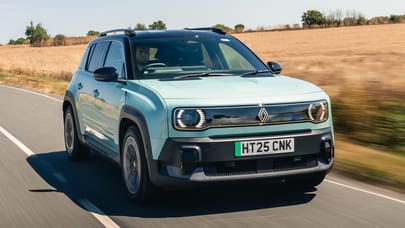
SPEC HIGHLIGHTS
- BHP
165bhp
- 0-62
9.2s
- CO2
139g/km
- Max Speed
124Mph
- Insurance
group15E
Is the Mazda CX-5 exciting? Not in a normal way. But if you've caught a glimpse of the score already and scanned the verdict, you might be giving some thought to reading the rest of this review. And you should, because the CX-5 should be on your shortlist if you're buying a family car.
OK, it stumbles at the first hurdle. It's merely unobjectionable to look at. This is the first production car to boast Mazda's new ‘Kodo' design language, and it's handsome and well proportioned.
But not striking. It's no Evoque. It's one of those shapes that works better in the metal than on the page, and there are some interesting character lines, but in most colours and weather conditions they're too delicate to stand out.
This is a shame, as there's plenty of new technology under the skin that actually works and actually makes a real difference. Most all-new cars have a certain level of carry-over from predecessors or other models in the range, but not the CX-5.
Engines, gearboxes, chassis, suspension - there's nothing here that's been anywhere else before. OK, some cabin trim and switchgear but nothing of real consequence.
So we have a lot to talk about. And we'd better start with the Skyactiv engines. The CX-5 comes with either a 163bhp, 2.0-litre petrol or a 2.2-litre diesel (148bhp or 173bhp). So far, so conventional, but what's unusual is that both have a 14:1 compression ratio. For a spark-ignition petrol this is ridiculously high; for a compression-ignition diesel, remarkably low.
There are plenty of good engineering reasons why we haven't had engines like this, but as programme manager Hideaki Tanaka points out: "In the gasoline, the high compression means more torque and better combustion efficiency; in the diesel, lowering the ratio helps cleaner combustion, reduces mechanical loads and the weight of the engine."
The petrol is also un-turbocharged, which is unusual, and is a bit noisier under load than most. It's nice to use, torquier than you might expect, but can be largely ignored as it will account for only 15 per cent of sales.
The diesel is a peach. It's remarkably smooth and quiet, and, if you want, you can take it beyond 5,000rpm and it won't get all shouty. But there's no need, because, as with all diesels, the good stuff happens from 1,500 to 3,500rpm. And 148bhp is all you need, tugging the CX-5 along without apparent effort.
It really has got a good turn of speed, runs silently and yet claims 61.4mpg and 119g/km of CO2. Neither a Ford Kuga nor Toyota RAV4 dips below 150g/km or manages over 50mpg. Mazda's clearly doing something right.
Top Gear
Newsletter
Thank you for subscribing to our newsletter. Look out for your regular round-up of news, reviews and offers in your inbox.
Get all the latest news, reviews and exclusives, direct to your inbox.
But getting those figures requires you to resist two tempting options: the auto 'box and the 4WD system. The 4WD makes little discernible difference to everyday driving and can only push a maximum of 50 per cent of torque to the rear wheels.
The auto is great to use - it has the uncanny knack of knowing which gear it needs to be in and when to change into it. So, the sweet spot of the range is the basic manual diesel. It has a good, crisp gearshift (the throw is as short as the MX-5's, apparently) and can be had in two trims: SE-L and Sport.
We mention them now because the difference between them isn't restricted to cost and kit. Upgrading to Sport costs £2,200 and adds xenon lights, a reversing camera, electric leather heated seats, a keyless system and 19in alloys. It also changes the driving manners.
There's no difference to the suspension settings, but the 17s fitted to the SE-L have more squidge in their tall 65-profile sidewalls, which softens the ride and takes the edge off body control. This isn't a problem because every CX-5 drives with panache.
It's the comfort and refinement that are most obvious. Mazda has used a new insulation material in the construction, and it gives the CX-5 a similarly hushed, isolated cabin to the best German execs.
It just feels very mature to drive, and Mazda - matched only by Ford in the mainstream sector - does dynamics better than just about anyone else. The bigger-wheeled Sport is taut and agile around corners, steers nicely and maintains momentum. The ride might be a fraction stiffer, but all CX-5s have an easy-going, relaxed feel ideal for family life.
They're big inside, too. The CX-5 looks Qashqai-sized, but that's misleading - it's bigger, with plentiful rear head- and legroom and a holiday-sized 503-litre boot. Handles drop the 40:20:40 split rear seats for a 1,620-litre bay.
Criticisms? The interior design and quality. It ought to have been more dramatic and interesting, the plastics and materials more tactile. But that's about it, though.
This is a good car, a fine family SUV that will serve you well, if unremarkably. It's on sale from 18 May, and its arrival signals the phasing out of the larger CX-7, like the 2 supermini, one of Mazda's underrated, underappreciated cars. Let's hope the CX-5 avoids the same fate. It deserves to.
Featured

Trending this week
- Car Review
BMW 1 Series
- Car Review
Honda Civic eHEV
- Top Gear's Top 9
Nine dreadful bits of 'homeware' made by carmakers




